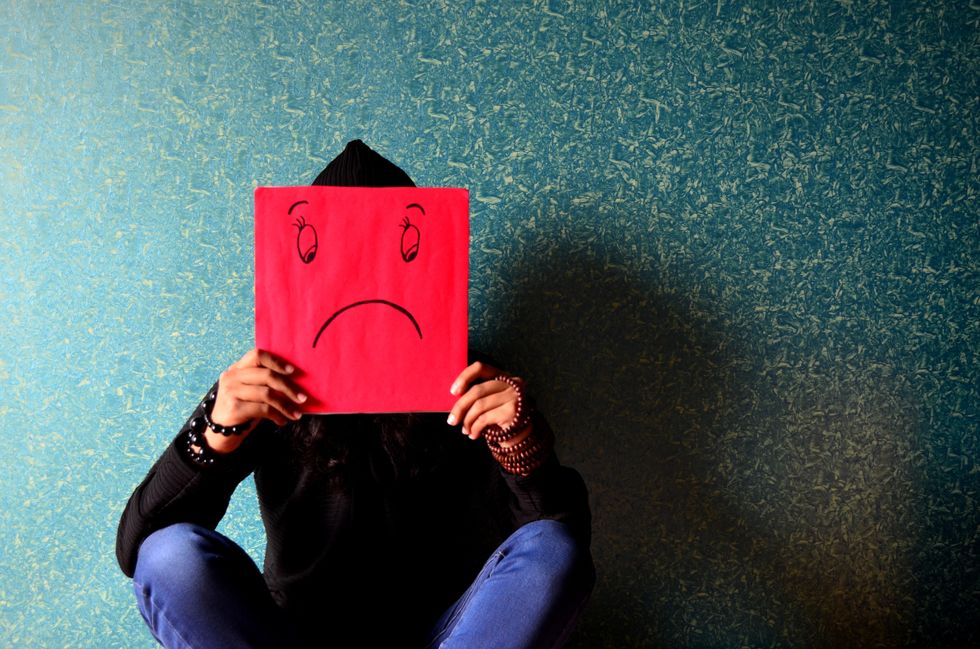For the past few months I’ve found myself to be incredibly out-of-order in terms of emotions and physical health. In the first semester of the school year I was admittedly the happiest I have ever been in my life.
I was excited to start at Temple University and begin studying something I'm passionate about. I was a member of the cheerleading team, where I made an entire group of new friends prior to the school year even starting. I was living with my best friends and hanging out with them every hour of the day. My relationships with my loved ones were closer than ever. I had nothing to complain about.
Along with the sunshine and high temperatures, my attitude and personality was radiant.
What I thought was to be coincidental, my beaming charisma was disappearing just as quickly as the temperatures were descending. It took me until late December to realize that I was nothing like the person that I was just over a month ago, and it only got worse from there on out.
I lost interest in the things I loved: I would have to drag myself to cheerleading practice against my will, even though I knew my friends awaited me in the gym. I endured the most relentless writer’s block I’ve ever dealt with. I stopped caring about my healthy eating and exercise habits and wanted nothing other than to eat junk food instead of legitimate meals every day.
My happiness was dwindling to the point where the only emotions I felt were variations of sadness. Angry sadness, empty sadness, and the list goes on and on. All I wanted to do was sleep, and if I wasn’t sleeping I was drowning in schoolwork.
Once my relationships with my friends and family were affected, I was encouraged to talk to a professional and get a better understanding of what was going on. After discussions about my behavioral patterns, weight gain, and emotions, my doctor suggested that I was experiencing a bout of the “winter blues” and potentially a case of Seasonal Affective Disorder.
I was intrigued by the concept of a seasonal-dependent mental illness, so I pursued some research and searched for people experiencing this in hopes to shed a light on SAD.
What is Seasonal Affective Disorder?
Seasonal Affective Disorder is defined by the National Institute of Mental Health as a specific variation of depression that displays a recurring seasonal pattern, typically starting in late fall and early winter, and going away during the spring and summer. Depressive episodes linked to the summer can occur, but are much less common than winter episodes of SAD.
It’s particularly difficult to pin a SAD diagnosis because many variations of depression or mental health disorders and illnesses yield similar symptoms and behaviors. However, it is possible to diagnose through multiple different processes such as a physical exam, lab tests, and most likely a psychological evaluation.
The National Institute of Mental Health states that to be diagnosed with SAD, “people must meet full criteria for major depression coinciding with specific seasons (appearing in the winter or summer months) for at least 2 years.”
If you haven’t heard about Seasonal Affective Disorder, appropriately abbreviated as “SAD,” that’s okay. It’s probably because the first use of the term wasn’t until 1984 at the National Institute of Mental Health in Bethesda, MD.
SAD is often referred to as the “winter blues.” This is experienced by an even greater abundance of the population who identify with the typical symptoms of SAD, but not severely enough for diagnosis as a clinically recognized syndrome.
The symptoms of Seasonal Affective Disorder vary among individuals, as per the case with most other disorders and illnesses. The most notable signs and symptoms of SAD include feeling depressed most of the day (nearly every day), losing interest in activities once enjoyed, having low energy/feeling fatigued, having trouble sleeping, experiencing changes in your appetite or weight, feeling sluggish/agitated, having trouble concentrating, or even having frequent thoughts of death or suicide.
I put out a brief explanation of Seasonal Affective Disorder on my social media and urged my friends, family, and all of my followers who have been affected by this to reach out to me and describe their experience with this disorder and how they’ve coped with it, if they were willing to do so.
I received messages, texts, emails and calls acknowledging that Seasonal Depression is real, and the number of responses itself proved that it is certainly not uncommon.
Through these messages, it’s become more evident that Seasonal Depression doesn’t discriminate. It affects old and young people, males and females, and people who come from different ethnicities and cultural backgrounds.
SAD is diagnosed four times more often in women than in men. It is
also more likely to affect young adults than it is to affect older adults.
There is one trend in particular that stood out to me: the majority of those who reached out to me expressing their struggle with Seasonal Depression happen to be young adults, specifically college students. Curious as to how many dimensions there are to youth's struggle with SAD, I then continued to ask these students how SAD affects their lives specifically in terms of academics and other aspects of the college experience.
A junior at West Chester University explained to me that her roommate struggled with SAD so she’s witnessed its impact firsthand, while experiencing it secondhandedly. Her emphasis was upon the fact that the “winter blues” is so normal, that it isn’t surprising how prevalent SAD is.
“Spring semester is extremely hard. All motivation is gone and the weather is just beyond terrible that the overall environment of school isn’t as fun as fall semester. I know from experience that my grades are usually slightly lower because I literally have zero motivation. It’s like summer is so close, but so far away, and winter break doesn’t allow enough time to recuperate and prepare for an intense semester. So I believe that SAD is 100% a real thing. I also learned about it in one of my classes, when a classmate explained their struggle with SAD and how they use special lighting in their home to help with it.”
After further understanding the mental and physical burden that SAD bestows on this group of young adults, I was curious to find out how they’ve coped with their symptoms and adjusted their behaviors to better deal with SAD. (Especially in the midst of their complicated schedules balancing academia, work, extracurriculars, and even athletics.)
“When I feel like I’m hitting a low point, I often get out of my house and go hangout with my friends. That usually puts me in a better mood. But if it doesn’t work and the bad feelings progress, I go talk to my therapist. It might not make me feel better initially, but it helps me process my emotions. When you have a better grasp of your emotions, it becomes easier to manage the symptoms when they pop up. I tend to keep myself busy during these months so I don’t have to be alone so often and I never hesitate anymore to reach out for help when I need it. I feel confident now that I can handle these problems.”
As my friend at Rutgers University stated, keeping oneself busy is a popular way to alleviate some of the harshest bouts of depression. One of my fellow students at Temple University , a senior, also opened up to me about her struggle with Seasonal Affective Disorder.
“As a student, it’s hard to cope with these emotions when you have to balance so much and try to have a good attitude with everything even though SAD is just always there.”
She also emphasizes the importance of keeping herself busy in the winter months, and believes it’s the only way she can have control over the situation. There are numerous ways to keep oneself busy, such as writing down things you’re thankful for, trying new recipes, joining a new club, or connecting with animals in the local animal shelter.
One of the most popular and oldest forms of treatment is light therapy, also called phototherapy, which consists of a special light box that exposes bright lights (which mimic outdoor light) to an individual with SAD within the first hour that they wake up every day. Read here to see how Norway and Sweden have implemented these technologies into alleviating symptoms of SAD.
In other cases, medication is offered as a method of treatment, usually consisting of antidepressant or serotonin-affecting medicines. Additionally, psychotherapy is a traditional method used to treat those with various forms of depression.
As for myself, I've become comfortable with confiding in my close friends and family members. Being honest and outwardly expressing my emotions is difficult at times, but necessary. I am lucky enough to have a support system that is aware of the severity of Seasonal Affective Disorder and even the "winter blues." I also have found peace of mind in the fact that spring weather is (hopefully) right around the corner.
If you believe that you or a loved one may be suffering conditions that indicate a presence of Seasonal Affective Disorder, reach out to your doctor for a further inquiry.
Here's to sunshine, warm weather, and better days.



















